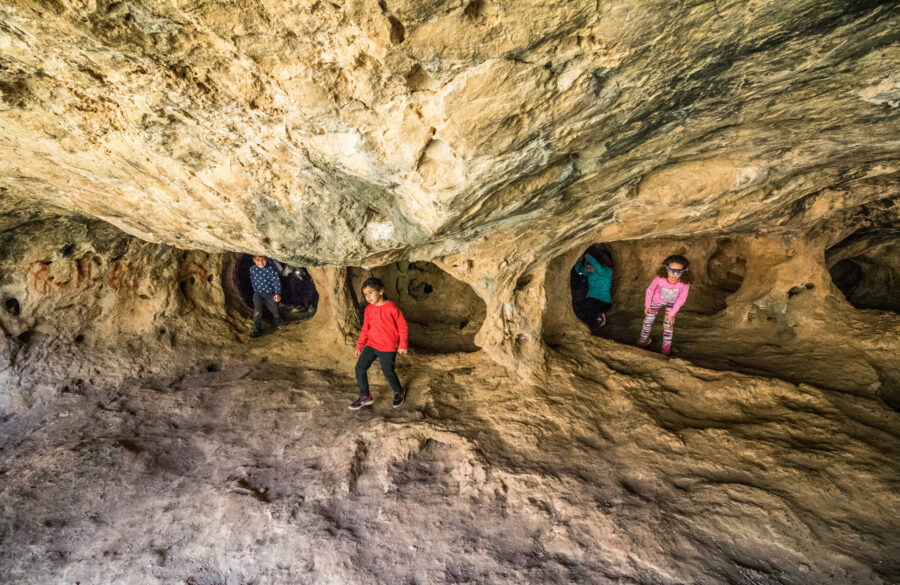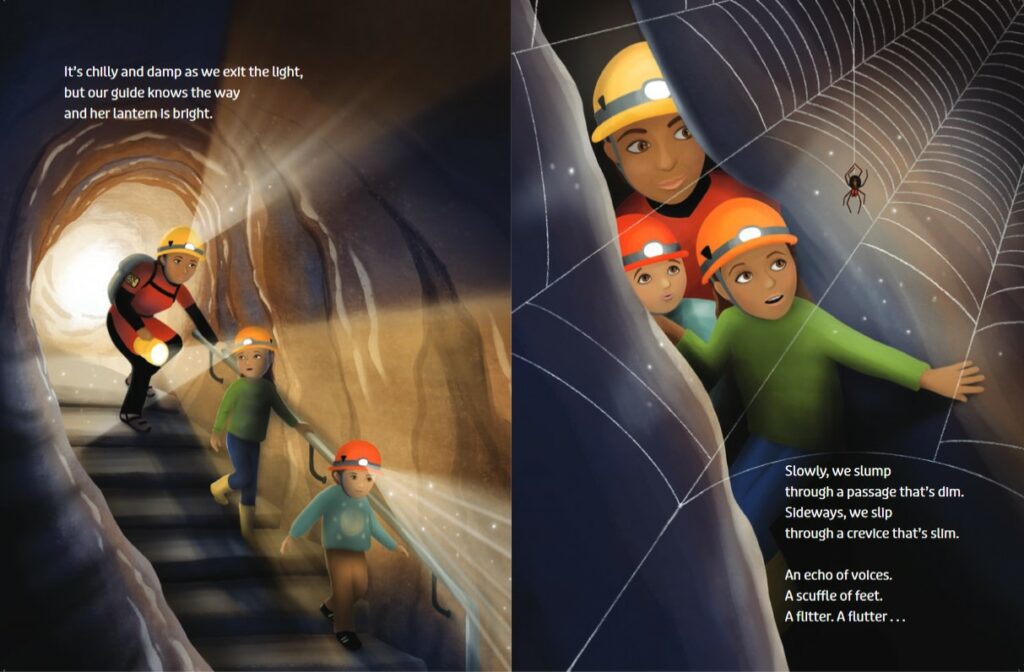GUEST BLOGGER HEATHER FERRANTI KINSER
Poetry and nature go together. Nature inspires us to describe its power, beauty, and complexity. And when humans try to describe the indescribable, the result is…poetry! That’s how I ended up releasing two poetic picture books this year. Today’s post, which ties into my rhyming book In a Cave, is all about playing with rhyme in nature writing. (For my previous lesson plan on playing with metaphor in nature writing, see my September 2023 LitLinks post.)
What are the elements of good rhyme in a picture book?
A good rhyming picture book is hard to achieve. That’s because rhyme alone isn’t enough to make for a pleasant reading experience. The poetic meter of a piece has to be precisely managed as well, in order for the reading to be smooth and seamless rather than an awkward slog. But there’s more! Other poetic devices will bring the story alive. Techniques such as:
- Repetition – saying a similar thing several times over, for effect
- Alliteration – the repetition of the same sound at the start of a series of words
- Assonance – the repetition of the same vowel sound within words
- Consonance – the repetition of the same consonant sound within words
Additionally, storytelling elements—such as setting, sensory details, tension, and humor—are also essential to a good rhyming picture book.
Without these elements, a rhyming piece can feel contrived and monotonous. With them, nonfiction writing can come alive in a way that seamlessly blends literature and STEM.
How does In a Cave make use of rhyme?
In a Cave is written with an AABB rhyme scheme. For instance, in the first stanza, the rhyming words are: unseen/green and door/explore.
How does In a Cave make use of poetic meter?
Poetic meter is the pattern of stressed and unstressed syllables in a poem. In a Cave is written in the poetic meter called anapestic tetrameter. Imagine that poetic meter is a drumbeat. Anapestic tetrameter sounds like “da-da-DUM” repeated four times in a line of poetry—like this line from my book (with the stressed syllables in caps):
But our GUIDE knows the WAY and her LANtern is BRIGHT.
Once in a while, at the beginning or end of a line, an unstressed syllable can be dropped—but never a stressed syllable! An example from my book is:
It’s CHILly and DAMP as we EXit the LIGHT.
Activity 1: Explore the rhymes of In a Cave
Part 1
Together or in small groups, read In a Cave and ask students to find all the end rhymes. Jot down the rhymes as the students call them out. How many rhyming pairs did they find? Do they have a favorite? Can they think of any other words that rhyme with these ones?
Part 2
Ask the students to convert two rhyming lines from the story into plain language. For example, instead of “A cave is a castle, beneath and unseen, away from the sky and the birds and the green,” what if the author had written, “A cave is a dark underground space full of strange rock formations.” Can students describe and compare the feeling of those lines? Which one gives them a stronger feeling? Which one is more memorable?
Activity 2: Explore the poetic meter of In a Cave
Part 1
Ask the students to find the poetic meter of In a Cave (anapestic tetrameter) by clapping it out as they say some lines aloud—two soft pats for the unstressed beats, then one loud clap for the stressed beat. How does it feel to find that rhythm? Would they like to stomp the rhythm, drum the rhythm, or even skip to the rhythm?
Part 2
Now, ask the students to write a line of anapestic tetrameter, on any topic. All that matters is that the line should sound like “da-da-DUM” repeated four times, when spoken in a natural way. As for the line they write, anything goes—even if it’s nonsense!
Here are some examples:
- In a shoe by the sea lived a sock and a foot.
- I will play on the swing ‘til the sky starts to cry.
- When I rode to your house on my bike it was night.
Ask the students to share their finished lines with the group, and clap along.
Activity 3: Explore the poetic devices and storytelling elements of In a Cave
Ask the students to look for other poetic devices or storytelling elements in In a Cave. Can they find examples of…
- Alliteration
- Assonance
- Repetition
- Sensory detail
- Tension
- Humor
Do they think these elements make the story more exciting? More fun? More memorable?
Activity 4: Create your own rhyming stanza with a poetic meter
In small groups, or together as a class, ask the students to think of something in the natural world that they would like to write about.
Next, ask them to brainstorm words having to do with that thing. For example: elephants, ears, trunk, stomp, herd, savannah
Now, can they think of any words that rhyme with one of those brainstormed words? The best choice will be a word that can help them say something significant about their topic. An online rhyming dictionary, such as RhymeZone.com, can be a lifesaver here!
Finally, can they find a way to write their rhyming stanza (of either two or four lines) with a consistent repeating pattern of stressed and unstressed syllables?
For example:
An elephant has floppy ears
that swish and flap if danger nears.
Encourage the students to keep playing with rhyme, meter, and the natural-world topics that interest them!
Featured image credit: “PikiWiki Israel 82994 children in flute caves” by דוידי ורדי is licensed under CC BY 2.5.
Heather Ferranti Kinser writes at the intersection of story, poetry, and nature from her home on the San Francisco Peninsula. She’s a former technical editor who now spends her days writing small stories—to make a big difference for kids! Heather is also the author of Small Matters and Nature Is a Sculptor (both from Millbrook Press). Connect with Heather on her website, HeatherKinser.com, or through her social media handle @hethfeth, on Twitter and Instagram.












Leave a Reply
Your email is safe with me.